
The Deposition is a 1619 painting by the Flemish artist Anthony van Dyck. It dates to around 1619 and reworks his 1615 version of the same subject [1] It is held in the Ashmolean Museum, in Oxford, where it was offered by Charles T. Maude in 1869.

The Deposition is a 1619 painting by the Flemish artist Anthony van Dyck. It dates to around 1619 and reworks his 1615 version of the same subject [1] It is held in the Ashmolean Museum, in Oxford, where it was offered by Charles T. Maude in 1869.
Deposition may refer to:
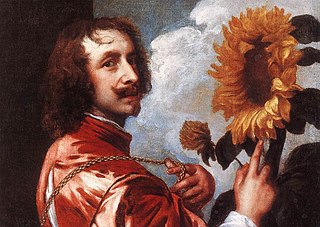
Sir Anthony van Dyck was a Flemish Baroque artist who became the leading court painter in England after success in the Spanish Netherlands and Italy.

The Bowes Museum is an art gallery in the town of Barnard Castle, in County Durham in northern England. It was built to designs by Jules Pellechet and John Edward Watson to house the art collection of John Bowes and his wife Joséphine Benoîte Coffin-Chevallier, and opened in 1892.
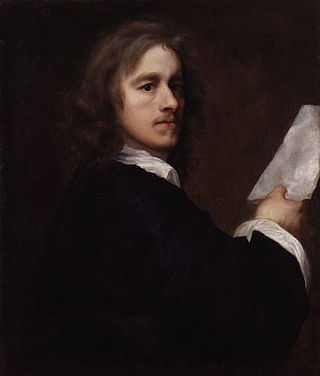
Robert Walker (1599–1658) was an English portrait painter, notable for his portraits of the "Lord Protector" Oliver Cromwell and other distinguished parliamentarians of the period. He was influenced by Van Dyck, and many of his paintings can now be found at the National Portrait Gallery, London.
Sir Oliver Nicholas Millar was a British art historian. He was an expert on 17th-century British painting, and a leading authority on Anthony van Dyck in particular. He served in the Royal Household for 41 years from 1947, becoming Surveyor of The Queen's Pictures in 1972. He was the first Director of the Royal Collection from 1987. He served in both offices until his retirement in 1988.

Adriaen Hanneman was a Dutch Golden Age painter best known for his portraits of the exiled British royal court. His style was strongly influenced by his contemporary, Anthony van Dyck.

Isabella Brant was the first wife of the Flemish painter Peter Paul Rubens, who painted several portraits of her.
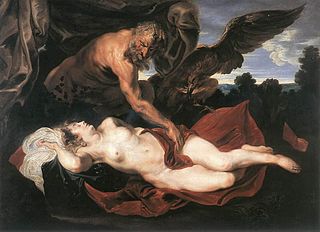
Jupiter and Antiope is a series of two similar oil-on-canvas paintings by the late Baroque Flemish painter Anthony van Dyck. One painting is in the collection of the Museum of Fine Arts, Ghent; the other in the Wallraf-Richartz Museum, Cologne.

Portrait of Queen Henrietta Maria, as St Catherine is a painting by Sir Anthony van Dyck.

Christopher Paul Hadley Brown, CBE is a British art historian and academic. He was director of the Ashmolean Museum in Oxford, England from 1998 to 2014. He is recognised as an authority on Sir Anthony van Dyck.
Sir Christopher John White CVO FBA is a British art historian and curator. He is the son of the artist and art administrator Gabriel White. He has specialized in the study of Rembrandt and Dutch Golden Age painting and printmaking.

The Portrait of Olivia Porter is an oil painting on canvas by Anthony van Dyck, showing Olivia, Lady Porter, the wife of Sir Endymion Porter, daughter of John Boteler, 1st Baron Boteler of Bramfield, and niece of the Duke of Buckingham, a zealous Roman Catholic and a lady in waiting to Henrietta Maria of France, queen consort to Charles I of England. It was discovered on the Your Paintings website by Bendor Grosvenor after being documented by the Public Catalogue Foundation.

Saint Ambrose barring Theodosius from Milan Cathedral is a painting of c. 1619–20 by Anthony van Dyck in the National Gallery, London.

Entry of Christ into Jerusalem is a 1617 oil painting by Flemish artist Anthony van Dyck, located in the Indianapolis Museum of Art, which is in Indianapolis, Indiana. It depicts Jesus entering Jerusalem as described in the Gospels, the event celebrated on Palm Sunday.

Magistrate of Brussels is an unfinished oil painting or oil sketch by Anthony van Dyck, rediscovered in 2013 after being shown on episodes of the BBC television programme Antiques Roadshow.
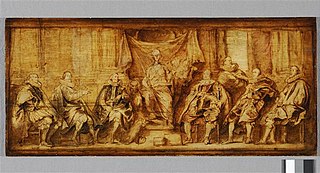
Magistrates of Brussels was a 1634-35 oil painting by Anthony van Dyck. It was destroyed in the French bombardment of Brussels in 1695. Its composition is known from a grisaille sketch in the École nationale supérieure des Beaux-Arts in Paris, which Van Dyck prepared to show how he planned to lay out the work.
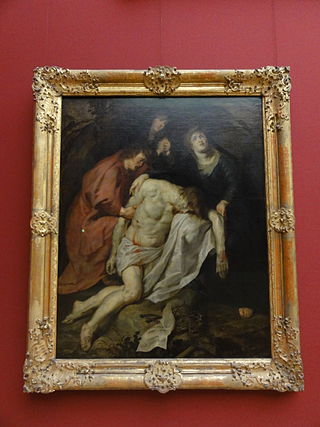
The Deposition is a 1615 painting by the Flemish artist Anthony van Dyck. It is now in the Alte Pinakothek in Munich. He later reworked it in his 1619 version of the subject.

Nicolaas Rockox (1560–1640), was a mayor of Antwerp. He was a close personal friend and important patron of Peter Paul Rubens. His residence in Antwerp is now a museum known as the Rockox House. He was knighted by Archduke Albert and Isabella, the Governor General of the Southern Netherlands.

The Apostle Matthew is a c. 1618-1620 painting by the Flemish artist Anthony van Dyck depicting Matthew the Apostle. One of its inspirations was probably the series of paintings of the Apostles he had seen in his master Rubens' studio around 1610, produced for the Duke of Lerma. The smooth brushwork is consistent with the painter's other works from first period in Antwerp.

Saint Rosalia Crowned by Angels is an oil on canvas painting by the studio of Anthony van Dyck, created c. 1624, one of several works showing the saint produced whilst van Dyck was quarantined in Palermo, Sicily due to a plague. It is now in the Galleria Regionale del Palazzo Abatellis in Palermo, where in 2015 it was displayed alongside Saint Rosalie Interceding, loaned from the Metropolitan Museum of Art.